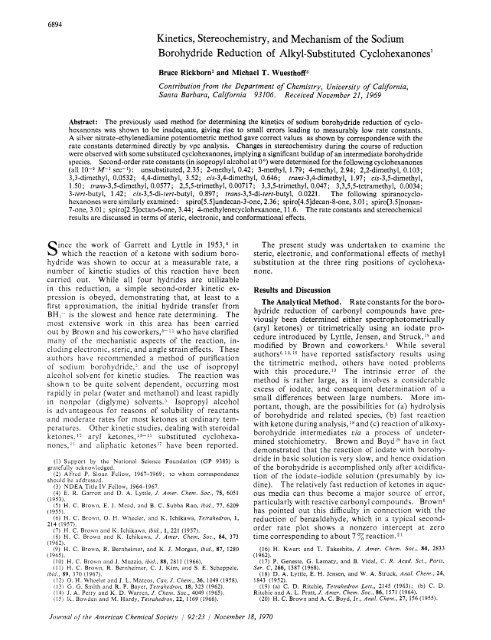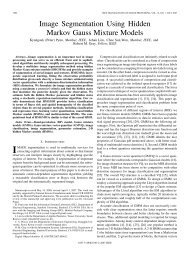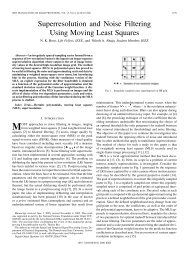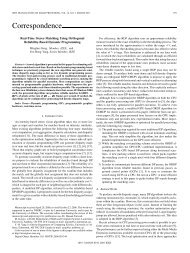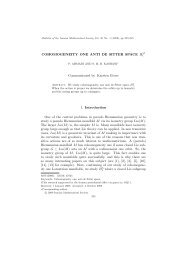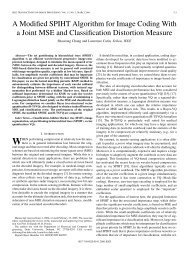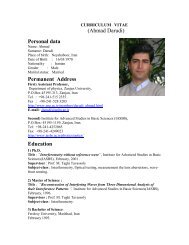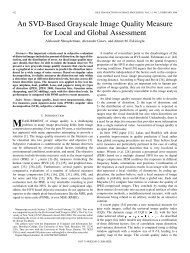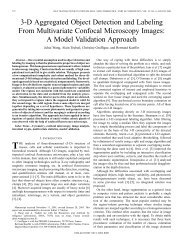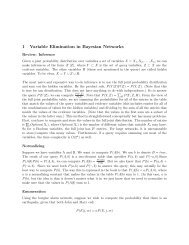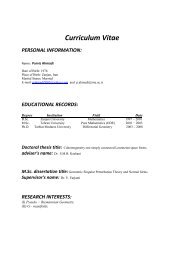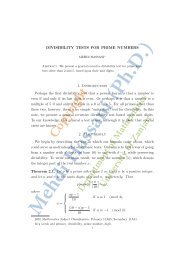1c.pdf
1c.pdf
1c.pdf
You also want an ePaper? Increase the reach of your titles
YUMPU automatically turns print PDFs into web optimized ePapers that Google loves.
6894<br />
Kinetics, Stereochemistry, and Mechanism of the Sodium<br />
Borohydride Reduction of Alkyl-Substituted Cyclohexanones'<br />
Bruce Rickborn2 and Michael T. Wuesthoff3<br />
Contribution from the Department of Chemistry, University of California,<br />
Santa Barbara, California 93106. Received November 21, 1969<br />
Abstract: The previously used method for determining the kinetics of sodium borohydride reduction of cyclohexanones<br />
was shown to be inadequate, giving rise to small errors leading to measurably low rate constants.<br />
A silver nitrate-ethylenediamine potentiometric method gave correct values as shown by correspondence with the<br />
rate constants determined directly by vpc analysis. Changes in stereochemistry during the course of reduction<br />
were observed with some substituted cyclohexanones, implying a significant buildup of an intermediate borohydride<br />
species. Second-order rate constants (in isopropyl alcohol at 0') were determined for the following cyclohexanones<br />
(all A4-I sec-I): unsubstituted, 2.35; 2-methyl, 0.42; 3-methyl, 1.79; 4-methyl, 2.94; 2,2-dimethyl, 0.103;<br />
3,3-dimethyl, 0.0532; 4,4-dimethyl, 3.52; cis-3,4-dimethyl, 0.646; truns-3,4-dimethyl, 1.97; cis-3,5-dimethyl,<br />
1.50; fruns-3,5-dimethyl, 0.0577; 2,5,5-trimethyl, 0.00717; 3,3,5-trimethyl, 0.047; 3,3,5,5-tetramethyl, 0.0034;<br />
3-tert-butyl, 1.42; cis-3,5-di-tert-butyl, 0.897; truns-3,5-di-terr-butyl, 0.0221. The following spiranocyclohexanones<br />
were similarly examined: spiro[5.5]undecan-3-one, 2.36; spiro[4.5]decan-8-one, 3.01 ; spiro[3.5]nonan-<br />
7-one, 3.01 ; spiro[2.5]octan-6-one, 3.44; 4-methylenecyclohexanone, 11.6. The rate constants and stereochemical<br />
results are discussed in terms of steric, electronic, and conformational effects.<br />
ince the work of Garrett and Lyttle in 1953,4 in<br />
S which the reaction of a ketone with sodium borohydride<br />
was shown to occur at a measurable rate, a<br />
number of kinetic studies of this reaction have been<br />
carried out. While all four hydrides are utilizable<br />
in this reduction, a simple second-order kinetic expression<br />
is obeyed, demonstrating that, at least to a<br />
first approximation, the initial hydride transfer from<br />
BH:-- is the slowest and hence rate determining. The<br />
most extensive work in this area has been carried<br />
out by Brown and his coworkers,j-" who have clarified<br />
many of the mechanistic aspects of the reaction, including<br />
electronic, steric, and angle strain effects. These<br />
authors hake recommended a method of purification<br />
of sodium borohydride,; and the use of isopropyl<br />
alcohol solvent for kinetic studies. The reaction was<br />
shown to be quite solvent dependent, occurring most<br />
rapidly in polar (water and methanol) and least rapidly<br />
in nonpolar (diglynie) solvents.; Isopropyl alcohol<br />
is advantageous for reasons of solubility of reactants<br />
and moderate rates for most ketones at ordinary temperatures.<br />
Other kinetic studies, dealing with steroidal<br />
ketones, l? aryl ketones, I3-I3 substituted cyclohexanones,<br />
I", and aliphatic ketones" have been reported.<br />
(1) Support by the National Science Foundation (GP 9383) is<br />
gratefully ackno\vkdged.<br />
(2) Alfred P. Sloan Fellow, 1967-1969; to whom correspondence<br />
should be addresscd.<br />
(3) NDEA Title IV Fellow, 1964-1967.<br />
(4) E. R. Garrett and D. A. Lyttle, J. Amer. Chem. Soc., 75, 6051<br />
(1953).<br />
(5) H. C. Bro\vn, E. J. Mead, and B. C. Subba Rao, ibid., 77, 6209<br />
( 1955).<br />
(6) H. C. Brown, 0. H. Wheeler, and I
In more recent work using the same analytical pro-<br />
cedure, Sun and Neidigzz found a significant intercept<br />
also for the reduction of phenyl cyclopropyl ketone.<br />
These authors suggested the possibility of some side<br />
reaction utilizing borohydride. An alternate explana-<br />
tion could involve any of the possibilities noted here.<br />
Our attempts to apply the modified potassium iodate<br />
procedureG for the kinetic analysis of cyclohexanone<br />
gave erratic rate constants with distinct, positive inter-<br />
cepts at zero time. A wide variety of oxidants and<br />
conditions were exploredz3 in an effort to develop a<br />
16e-<br />
2H104 + 3BH4- + HZO + 21- + 3HzB08- + 4H2 + 2H+<br />
more useful titrimetric procedure; with few exception~,*~<br />
however, added ketone substantially affected<br />
the analytical results.<br />
At this point we learned that the silver nitrate-ethylenediamine<br />
method of Brown and Boydz0 had been<br />
refined for use as a potentiometric technique.z4 This<br />
procedure was modified slightly (Experimental Section)<br />
for kinetic application, and shown to give good results<br />
with the cyclic ketones studied here. The method<br />
gives total hydride equivalence, not just BH4-. Nearly<br />
all compounds examined gave reproducible, straightline,<br />
second-order kinetic plots with zero time intercepts<br />
equal to zero within experimental error. zj<br />
The rate constants for the reduction of ketones 1-22<br />
obtained by this method are shown in Table I. For<br />
1 2 3 4 5 6<br />
n<br />
7 8 9 10 11<br />
12 13 14 15 16 17<br />
18 19 20 21 22<br />
(21) ,Calculated from the data given in ref 6; notc that Figures 2 and<br />
3 in this rcferencc have been interchanged.<br />
(22) S. F. Sun and P. R. Neidig, J. Org. Chent., 34, 1854 (1969).<br />
(23) The following gave unsatisfactory analytical results: potassium<br />
periodate, lithium iodate in IPA (isopropyl alcohol), potassium bromate,<br />
tetrainethylnnitiioiiiuni iodate in IPA, periodate acid (in water or IPA),<br />
iodic acid, sodium hypoiodite, iodine in IPA, ferric chloride in IPA or<br />
water, hydrogen peroxide, silver nitrate in IPA, silver acetate, salicylate,<br />
or lactate (insufficient solubility in IPA), silver fluoride or silver perchlor-<br />
ate in IPA. Of these reagents, only periodic acid gave reproducible re-<br />
sults and values which were unafected by the presence of ketone; how-<br />
ever, the reproducibility was somewhat dependent oii the ratio of peri-<br />
odic acid to borohydride, thus negating the usefulness of this reagent<br />
for kinetic analysis. The reaction of periodic acid with borohydride<br />
approximates the stoichiometry<br />
(24) We are indebted to Dr. Charles (Chips) Brown for suggesting<br />
this procedure and furnishing details of its application.<br />
(25) The reaction of AgED+ with borohydride occurs very rapidly<br />
0<br />
Table 1. Rate Constants (AgED" Method) for Reduction by<br />
Sodium Borohydride in Isopropyl Alcohol at 0"<br />
Compd 102k, ]./mol sec k,,l<br />
1<br />
2<br />
3<br />
4<br />
5<br />
6<br />
7<br />
8<br />
9<br />
10<br />
11<br />
12<br />
13<br />
14<br />
15<br />
16<br />
17<br />
18<br />
19<br />
20<br />
21<br />
22<br />
2.35 i 0.09*<br />
0.421 f 0.006n<br />
0.103 i O.OOlb<br />
0.00717 k 0.00001*<br />
1.79 f 0.03*<br />
0.0532 i 0.0007cL<br />
1.50 f 0.03"<br />
0.0577 f 0.0002b<br />
0.0470 i 0.0009
6896<br />
% reaction<br />
Figure 1. Stereochemical dependence on per cent reaction for<br />
2-methylcy clohexanone.<br />
niatography (vpc); values obtained by this method<br />
are shown in Table 11.<br />
Table 11. Comparison of Rate Constants (102k mol-' sec-l)<br />
Obtained by Vpc and AgED" Methods<br />
~~<br />
Ketone k (VPC) k (AgED+)<br />
2 0.399 i 0,006" 0.421<br />
4 0.00721 i 0.00006b 0.00717<br />
5 2.17 i 0.19* 1.79<br />
7 1.61 i 0.1BC 1.50<br />
9 0.0455 & 0.0004 0.0470<br />
11 0.82 ir 0.10" 0,646<br />
I2 2.43 i O .lOb 1 .97<br />
13 1.48 i 0.03d 1.42<br />
14 0.84 i 0.02,i 0,897<br />
16 3.19 C 0.04" 2.94<br />
'I Average deviation from the mean of five determinations.<br />
C Two determinations. Four determinations. ri Three determina-<br />
tions.<br />
The ~ p c method is inherently subject to greater<br />
error26 than a titrimetric procedure, and consequently<br />
the agreement between the rate constants from the<br />
AgED- and vpc methods can only be described as<br />
excellent. In the few cases where the values differ<br />
beyond the aberage deviations, the vpc rate constants<br />
are higher, i.c., in the wrong direction to fortify the<br />
values obtained by- the iodate procedure. The data<br />
clearly indicate that the AgED+ method is yielding<br />
the correct absolute rate constant for sodium borohydride<br />
reduction of ketones in isopropyl alcohol.<br />
Observation of an Intermediate. In the course of<br />
vpc rate determinations, an interesting and unexpected<br />
observation was made. The ketones used in each case<br />
give rise to two isomeric alcohols, and the ratio of these<br />
products changed duriiig the cowsc of reducrion.<br />
Car e f ul con t r 01 experiments were undertaken, subjecting<br />
several product mixtures to the analytical and<br />
extraction procedures used to prepare the vpc samples.<br />
This treatment did not affect the alcohol ratios, ruling<br />
out ?he possibility that the changing ratios might be<br />
an artifact of the conditions used.<br />
Equation 1 was chosen as a mathematical expression<br />
adaptable to the h'pc data, and readily fit to the different<br />
data sets by a computerized least-squares analysis.<br />
a< alcohol A = Alan - B (% reaction -<br />
The equation of best fit to the data was used to obtain<br />
extrapolated product ratios at 0 and 100% reaction.?'<br />
(26) Relatively large error limits arc involved in area measurements at<br />
both high and low per cult ketone convcrsion.<br />
Journuf of the American Chemicul Society i 92:23 J Nocember 18, 1970<br />
(1)<br />
An example with experimental values and calculated<br />
curve for 2-methylcyclohexanone (2) is shown as Fig-<br />
ure 1.<br />
The extrapolated values for the various systems ex-<br />
amined are given in Table 111. All but two of the ten<br />
Table 111. Product Distributions as a Function of Per Cent<br />
Reaction; NaBH4 Reduction of Alkylcyclohexanones in IPA<br />
-- alcohol product-----<br />
Ketone 0% reactionY 100% reaction.<br />
2<br />
4<br />
5<br />
7<br />
9<br />
11<br />
12<br />
13<br />
14<br />
16<br />
25.1 & 2.5<br />
29.0 + 0.7<br />
12.6 i 1.2<br />
14.3 r 2.3<br />
58.1 i 1.8<br />
13.1 i 0.5<br />
11.9 & 0.9<br />
17.4 It 0.5<br />
18.7 =k 2.2<br />
11.2 =t 0.4<br />
39.9 i. 1.0cis<br />
29.4 i 0.8 trans<br />
23.8 i 0.1 trans<br />
26.6 x 0.4 trans<br />
61.7 i 0.9 trans<br />
18.4 i. 0.2 trans<br />
22.9 i. 0.6 trans, cisb<br />
23.9 i 0.2 trans<br />
29.9 i 0.7 trans<br />
23.9 lir 0.3 cis<br />
Average deviations obtained from the number of runs indicated<br />
in the footnotes of Table 11. This stereochemical designation<br />
refers to the geometry of the 3- and 4- methyl group, respectively,<br />
relative to the hydroxyl group.<br />
ketones examined show significant variation in product<br />
ratio with extent of reduction. The two exceptions<br />
are 2,5,5 - t r i me t h y IC y clo hexa no ne (4) a nd 3 , 3,5 - t r i-<br />
niethylcyclohexanone (9). These ketones differ from<br />
the others listed in Table 111 in one other regard;<br />
the rate constants for reduction are significantly lower<br />
for 4 and 9. Viewed in terms of the more stable chair<br />
conformations (;.e., with axial alkyl group and 1,3-<br />
diaxial interactions minimized), the axial alcohol prod-<br />
uct increases with extent of reaction for all ketones<br />
listed in Table 111. This trend would be anticipated<br />
if a bulkier reducing agent were developing during<br />
the course of reduction, and competing with sodium<br />
borohydride for remaining ketone. The results were<br />
obtained, as noted earlier, using approximately the<br />
stoichiometric ratio of ketone to borohydride (4: I),<br />
conditions which could conceivably cover a widc range<br />
in ratio of borohydride to intermediate alkoxyboro-<br />
hydride over the course of negligible to complete<br />
reduction.<br />
In order to test further the hypothesis of an inter-<br />
mediate, the stereochemistry of reduction of three<br />
ketones by excess sodium borohydride was examined.<br />
These data are presented in Table IV. Again the<br />
Table IV. Effect of Borohydride: Ketone Ratio on<br />
Stereochemistry of Reduction<br />
Ketone [NaBHaJ/[ketone] alcohol<br />
2 0.25<br />
2.63<br />
39.9 cis<br />
30.8<br />
7 0.25 26.6 trans<br />
2.77 17.6<br />
24.3 13.0<br />
9 0.25 61 ,7 trans<br />
1.28 60.6<br />
2.84 59.1<br />
25.3 54.9<br />
(27) In eq I, % alcohol A refers to thc per cent of onc of the cllcohols,<br />
arbitrarily chosen; Aloe is the per cmt A at 100% renction, and B is a<br />
curve-fitting constant.
more reactive ketones 2 and 7 exhibit greater sensitivity<br />
to excess borohydride concentration, in agreement with<br />
the data given in Table I11 and the previously noted<br />
small but real correlation between reagent concentra-<br />
tions and rate constants for the more readily reduced<br />
systems.<br />
Having established that some intermediate boro-<br />
hydride reduction species has a finite lifetime under<br />
these reaction conditions, attempts were made to ex-<br />
amine the nature of this intermediate. Viewing the<br />
reduction as a sequential four-step reaction (eq 2-5, K<br />
= ketone) and considering the enhanced hydride donor<br />
activity associated with alkoxy substitution on boron,<br />
one might expect the presumed initially formed alkoxy-<br />
borohydride (k,) to resemble most closely in reactivity<br />
borohydride itself, with subsequent reduction steps (eq 4<br />
and 5) being even faster. Consequently, we first at-<br />
tempted to prepare an alkoxyborohydride of the type<br />
involved in eq 3, using sodium isopropoxide and either<br />
borane-tetrahydrofuranate (in THF) or diborane.<br />
kl<br />
K + BH4- + BHa(0R)- ( 2)<br />
kz<br />
K + BHa(0R)- e BH%(OR)z- (3)<br />
K + BH*(OR)*- + BH(0R)s- (4)<br />
kd<br />
K + BH(0R)s- + B(OR)d- (5)<br />
Treatment of sodium isopropoxide with excess borane<br />
in THF gave a white precipitate which proved to be<br />
sodium borohydride, formed nearly quantitatively ac-<br />
cording to eq 6. Since borane might have acted to<br />
3NaO-i-Pr + 4BH3 B(O-i-Pr)a + 3NaBH, (6)<br />
catalyze the disproportionation of any sodium iso-<br />
propoxyborohydride formed, this experiment was re-<br />
peated using just 1 mol of borane/mol of alkoxide. Al-<br />
though the residue from vacuum removal of the volatiles<br />
from this reaction had the appropriate weight for the<br />
desired product, the proton nmr spectrum of the THF<br />
solution showed the presence of appreciable sodium<br />
borohydride; apparently disproportionation according<br />
to eq 7 had occurred.<br />
4NaBHa(O-i-Pr) + 3NaBH4 + NaB(O-i-Pr)4 (7)<br />
Finally, the reaction of solid sodium isopropoxide<br />
with gaseous diborane was examined. Heat was<br />
evolved. Vacuum removal of the volatile material<br />
gave a residue of sodium borohydride. Hence, even<br />
in the absence of solvent, disproportionation according<br />
to eq 6 occurs readily.28<br />
We next turned our attention to the presumed final<br />
intermediate in the reduction sequence (eq 5), the tri-<br />
alkoxyborohydride species. Attempted synthesis of<br />
tricyclohexyl borate by the general method of Brown,<br />
Mead, and Shoaf3" failed, giving an undistillable viscous<br />
(28) This facile disproportionation is analogous to the reported reaction<br />
of sodium methoxide with diborane [H. I. Schlesingcr, H. C.<br />
Brown, H. R. Hoekstra, and L. R. Rapp, J. Amer. Chem. SOC., 75, 199<br />
(195311. This observation does ]not, of course, rule out the alkoxyborohydride<br />
as a reactive intcrmcdiate in the reduction sequence. Jones<br />
and Wise29 have also attempted to examine the reaction of an alkoxyborohydride<br />
by treating a mixture of sodium 4-tert-butylcyclohexyl oxide<br />
and the corresponding ketone with diborane in diglyme solvent.<br />
This approach is subject to considerable uncertainty (even for stereochemical<br />
studies in diglyme) and was obviated in the present work by<br />
the fast reaction of diborane with isopropyl alcohol.<br />
(29) W. M. Jones and H. E. Wise, Jr., J. Amer. Chem. SOC., 84, 997<br />
(1962).<br />
k3<br />
6897<br />
liquid. Jones and Wisez9 have reported similar diffi-<br />
culties in the preparation of the 4-tert-butylcyclohexyl<br />
analog. Consequently, it was decided to work with<br />
the known sodium triisopropoxyborohydride.<br />
Brown31 has reported that this material reacts very<br />
rapidly with acetone in the solvents isopropyl alcohol,<br />
THF, and diglyme. It was felt that by using a very<br />
unreactive ketone it might be possible to follow a<br />
reduction kinetically, and 3,3,5-trimethylcyclohexanone<br />
(9) was chosen for this purpose. Having first established<br />
that AgED+ yields correct32 analytical values for tri-<br />
isopropoxyborohydride alone and in the presence of<br />
the reactive ketone 4-methylcyclohexanone, three ki-<br />
netic determinations were made at 0" in IPA. Again<br />
rather unexpected results were obtained. In two runs, a<br />
small excess of ketone 9 was used; the second-order<br />
rate plots indicated that by the time the first point<br />
was examined (within 2 min), half of the available<br />
hydride had been used. Subsequent reaction occurred<br />
at an easily determinable rate to give the constants<br />
shown in Table V. Several interesting aspects of this<br />
Table V. The Reaction of 9 with Sodium<br />
Triisopropoxyborohydride in IPA at 0"<br />
PI1 --lo%, I./mol sa- -z reaction at t = 0-<br />
[BH(O-i-Pr),-] AgED+ VPC AgED+ Vpc<br />
1.46 2.45 3.04 50 44<br />
1.32 2.41 2.43 49 53<br />
0.63 -4.8 -3.9 67 70<br />
reaction are evident from these data. The large y<br />
intercept (extent of reaction at tinie zero) is not due<br />
to (a) reaction of BH(O-i-Pr):l- with solvent, as shown<br />
by the correspondence of AgED+ and vpc rate con-<br />
stants, or (b) fast reaction during the quenching step,<br />
since the BH(O-i-Pr)3- analysis was unaffected by the<br />
presence (in the quenching solution) of the much more<br />
reactive ketone 16. It must therefore be caused by<br />
an initial very fast reaction followed by a measurably<br />
slower second-order reaction. The observation that,<br />
with excess ketone, 50% of the available hydride is<br />
consumed in the fast step appears to be significant. A<br />
possible mechanistic explanation is shown in eq 8-12.<br />
2BH(O-i-Pr):l- IT BH2(0-i-Pr)2- + B(O-i-Pr),i- (8)<br />
k 1<br />
BHp(O-i-Pr)p- + K --+ BH(O-i-Pr)2(OR)-<br />
2BH(O-i-Pr)2(OR)- e BH2(0R)p- + B(O-i-Pr),- ( 10)<br />
(9)<br />
BH,(OR),- + K + BH(OR),t- (1 1)<br />
2BH(OR)j- +E BH2(0R)2- + B(0R)r- (12)<br />
According to this scheme rapid disproportionation<br />
steps (eq 8, 10, 12) connect the rapid initial reduction<br />
(eq 9) and the subsequent slower reaction of eq 11. Al-<br />
(30) H. C. Brown, E. J. Mead, and C. J. Shoaf, ibrd., 78, 3613 (1956).<br />
(31) H. C. Brown, E. J. Mead, and C. J. Shoaf, ibrd., 78, 3616 (1956).<br />
(32) Analysis of active hydride under kinetic conditions was compli-<br />
cated somewhat by the coticurrctit reaction of triisopropoxyborohydride<br />
with IPA, for which an approximate first-order rate constant at 0" of<br />
1.5 X 10-1 scc-1 was obtained. Thc values from the AgED' method<br />
using freshly mixed solutions at 0" were in reasonable agreement with<br />
those obtained by hydrogen evolution, and were unaffected by ketone<br />
in the quenching solution. In contrast, the iodate procedurc gavc vcry<br />
low hydride values which were greatly affected by the presence of ketone.<br />
Rickborn, Wuesthof 1 Sodium Borohydride Reduction of' Cj~cfoliexanones<br />
I,. 2
6898<br />
I I<br />
though other explanations are possible, this schenie<br />
can accommodate the experimental observations.33<br />
These observations require that, at least on the time<br />
scale required for reduction, there is no facile exchange<br />
of alkoxide groups on boron with the IPA ~olvent.3~<br />
Since our data suggest that substituting a bulky (but<br />
still secondary) alkoxide for isopropoxide leads to a<br />
hydride donor of considerably diminished reactivity,<br />
it is clear that the relative rates of the “fast” steps<br />
in borohydride reductions (i.e., eq 3-5) cannot be safely<br />
generalized; a balance between electronic and bulk<br />
effects of the alkoxide groups could lend to the situation<br />
in which the next to slowest step might correspond<br />
to eq 3 for one ketone and eq 4 or 5 for another.<br />
The third run listed in Table V represents an at-<br />
tempt, through the use of insuficient ketone, to ob-<br />
serve ongoing reduction before the initial, reactive<br />
alkoxyborohydride species was consumed. Some cur-<br />
vature in the rate plot was observed, reflected in the<br />
higher approximate rate constant reported in the table.<br />
The greater extent of reaction (loss of ketone) at extrap-<br />
olated f = 0 is also in agreement with the suggested<br />
niech a nism .<br />
(33) A prcsuiiiably simpler cxplaiiation might avoid the initial disproportionation,<br />
i.r.<br />
BH(O-i-I’r),j- + K + B(O-i-l’r),4(OR)-<br />
B(O-i-Pr)s(OR)- + BH(O-i-Pr)3-<br />
1.1<br />
BH( 04- I’r)?(OR)- + B( 0-i- I?).,-<br />
/,<br />
BH(O-i-Pr)2(0R)- + K --% B(O-i-l’r)2(OR)L<br />
This schenie, hov,cvcr, implies that the tctraalkoxy bor.itc ion is a stable<br />
entity, whereas it is highly probable that rapid (;itid perhaps extensive)<br />
dissociation occurs. As such, the bulkier alkoxy group would be rii-<br />
B(O-i-Pr)J(OR)- I_ B(O-i-I’r),, + OR<br />
pidly lost from the reaction sequence (rcplaccd by isopropoxidc from<br />
solvent), making a simplified nicchuiistic schcme such as this uiitenablc.<br />
It is for this reason that we propose a dihydroboron species as the active<br />
reducing agent. Although sodium triisopropoxyborohydridc is rc-<br />
ported not to disproportionate (as in cq 8) appreciably 111 THF solvent,<br />
it is conceivable that a quite difcrcnt situation prcvails in IPA. Tri-<br />
methoxyborohydridc is kiiowiia” to disproportionate in this tiiaiiiicr.<br />
(34) In a recent study of the borohydride reduction a,@-uiisaturatcd<br />
aldehydes and ketone, an ctyort was made to examine this qucstion.35<br />
p-Alkoxy alcohols arc formed in this reaction; in IPA solvent, the<br />
alkoxy group is invariably derived from solvent. Addcd triisopropyl<br />
borate diminishes but does not totally prcvciit formation of these<br />
products. These data demonstrate (a) that the tetraisopropoxy borate<br />
anion disproportionatcs as discussed in ref 32; and (b) this dispropor-<br />
tionation leads to rapid equilibration of reduction product B-OR species<br />
\%ith solvent alcohol. Thus it appears necessary to call ou highly specific<br />
disproportionation steps (as in eq 8%12) to explain the present obscrvat<br />
ions.<br />
(35) M. R. Johnson and B. Rickborn, J. Org. Chem., 35, 1041 (1970).<br />
Journul (?f the Americun Chemical Society i 92:23 1 November 18, 1970<br />
The proposed mechanism also has certain stereo-<br />
chemical consequences, in particular that the bulkier,<br />
less reactive borohydride species should be more stereo-<br />
selective in its reaction. The vpc rate determinations<br />
(Table V) allowed the simultaneous observation of<br />
this phenomenon, as shown for the first two runs<br />
(with excess ketone) in Figure 2. If initial reduction<br />
were governed only by the very reactive species, and<br />
the latter half of the reduction controlled by a single<br />
bulkier alkoxyborohydride, a strictly linear behavior<br />
would be expected in Figure 2. Although there is<br />
some apparent curvature, the nearly linear behavior<br />
suggests that the reactive species first formed by dis-<br />
proportionation of triisopropoxyborohydride gives<br />
about 75x of the axial alcohol product: to account<br />
for the final total product distribution (86-87 2 axial),<br />
the bulkier reagent must be giving axial alcohol in a<br />
highly (nearly 100 %) stereoselective manner.<br />
Some time ago Haubenstock and Eliel”” reported<br />
that the molar ratios of sodium borohydride to 3,3,5-tri-<br />
niethylcyclohexanone had no effect on the stereochem-<br />
ical course of the reduction: a twofold excess of hydride<br />
gave the same aniount (55 i- 1 z) of axial alcohol<br />
as the stoichiometric ratio of reactants. They there-<br />
fore concluded that the subsequent steps in reduction<br />
must be a great deal faster than the initial hydride<br />
transfer, a conclusion augmented by the earlier kinetic<br />
studies. As we have seen, though, this particular<br />
ketone 9 is one which happens to be relnticc>lj. insen-<br />
sitive to the borohydride-substrate concentration ratio,<br />
as shown by the negligible change in stereochemical<br />
outcome through the course of a reduction under ap-<br />
proximately equivalent concentration conditions (Ta-<br />
ble 111) and the small change detected when a 100-fold<br />
excess of borohydride was used (Table IV). Since<br />
our data with t r i i so pr o pox y bo r o h y d r id e c le a r 1 y s ti o w<br />
that some bulkier hydride donor exhibits considerably<br />
higher selectivity (approaching 100 %) than borohy-<br />
dride itself, we also must conclude that, for this ketone,<br />
the subsequent reduction steps must be suficiently<br />
faster than the initial hydride transfer that no (or ii<br />
negligible aniount of) intermediate alkoxyborohydridc<br />
species is developed with this system. It should again<br />
be noted that this behavior is associated with ketones<br />
having the smallest rate constants, which could imply<br />
simply that the rate of the first hydride transfer for<br />
these compounds is diminished relatiLcly more than<br />
the rates for subsequent steps, when compared to<br />
the faster ketones. Comparison of the rate constant<br />
for borohydride reduction of 9 (Table I) and the con-<br />
stant for the presumed final (and possibly next-slowest)<br />
hydride transfer for this ketone (Table V) shows that<br />
the latter is faster by a factor of -50. A factor of this<br />
magnitude between the slowest and second-slowest hy-<br />
dride transfer steps would preclude the stcreocheniical<br />
observation of intermediate buildup under our kinetic<br />
conditions.<br />
The stereocheniistry of reduction by triisopropoxy-<br />
borohydride of two relatively unhindered ketones, cis-<br />
(36) (a) H. Haubenstock and E. L. Eliel, J. Amrr. Ciioii. Soc., 84,<br />
2368 (1962). (b) The stereochemical dependence 011 borohydride to<br />
ketone ratio also puts into question some observations on the tctiipcr‘i-<br />
ture dependence of this reduction process [P. T. Laiisbury and R. E.<br />
MacLeay, J. Org. Chem., 28, 1940 (1963)l. E\cn if this ratio ncrc<br />
maintained constant, the unknown tcmperaturc dcpcndcncc of thc<br />
reaction of any intermediate alkoxyborohydridc species \\oultl m~kc<br />
interpretation of temperature efects teiiuoiis.
3,5-dimethylcyclohexanone (7) and 4-methylcyclohexa-<br />
none (la), was also examined. The data are shown<br />
in Table VI. The second run with 7 was stopped<br />
Table VI. Reductions with Triisopropoxyborohydride in IPA at 0”<br />
[K]/[BH- Time, % re-<br />
Ketone (OR)s-] min action % alcohol<br />
I 1.2 3 20 100 46.7 trans<br />
I 1.2 12 94 43.2<br />
16 1.1 30 100 40,O cis<br />
short of completion as a check on possible, but unexpected,<br />
product equilibration. The greater amount<br />
of axial product in the longer time experiment excludes<br />
equilibration, and supports the observation made with<br />
ketone 9, i.e., that reduction with this reagent involves<br />
(at least) two hydride donor species of differing selectivity.<br />
The proportions of “axial” products are much<br />
higher than observed through the course of kinetic<br />
runs using borohydride (Table 111), as required by<br />
the proposed mechanism. Assuming a very fast initial<br />
consumption of half the available hydride (and ketone),<br />
an appropriate rate constant from the incomplete run<br />
with 7 can be calculated. This value, 22 X<br />
l./niol sec, is approximately 15 times faster than the<br />
rate constant for sodium borohydride. Although a<br />
crude value, this ratio is smaller than that found in<br />
reductions of 9 with the two reagents, and is in agreement<br />
with the suggestion that stereochemical observation<br />
of an intermediate alkoxyborohydride species is<br />
more probable with the more reactive ketones.<br />
Having taken some pains to demonstrate that a<br />
finite concentration of intermediate alkoxyborohydride<br />
species is developed during the course of sodium borohydride<br />
reduction of ketones, it becomes important<br />
to distinguish between stereochemical and kinetic observation<br />
of the intermediate. Thus, at first glance,<br />
it might seem that good straight-line second-order plots,<br />
as obtained and used for the rate constants in Table I,<br />
are inconsistent with the buildup of an intermediate.<br />
However, if the alkoxyborohydride intermediate has<br />
very different steric requirements leading to stereoselectivity<br />
in reduction which differs greatly from that<br />
observed with borohydride itself, any amount of intermediate,<br />
small but greater than steady state, can<br />
lead to stereochemical observation and still lie outside<br />
the range of kinetic detection. The good second-order<br />
plots suggest that, at least to a first approximation,<br />
this is the case with the systems examined in the present<br />
work. A consequence is that the rate constants, as<br />
reported in Table I, do represent, probably within a<br />
few per cent error at most, the true values for the<br />
initial hydride transfer from borohydride. Confidence<br />
limits of +=5z were set on individual rate constant<br />
determinations, and, as shown in Table I, the experimental<br />
values were quite reproducible.<br />
Alkyl Substituent Effects. Alkyl substitution can<br />
affect the rate of borohydride reduction of cyclohexanone<br />
in a variety of ways which can be classified as<br />
primarily inductive, steric, or conformational in nature.<br />
Kwart and TakeshitaI6 have shown that electronegative<br />
groups in the 4 position of this ketone exert a rateenhancing<br />
effect in reduction, and a linear free energy<br />
relationship is observed using inductive substituent con-<br />
6899<br />
stants. However, 4-alkyl substitution also caused small<br />
but real rate enhancement, an observation borne out<br />
by the present work. Kwart chose to invoke a novel<br />
inverse inductive effect for the alkyl group (both methyl<br />
and tert-butyl), citing kinetic data for the addition<br />
of an arylsulfenyl halide to substituted cyclohexene~~’<br />
to support this thesis. It has subsequently been shown,<br />
however, that similar rate effects in epoxidati~n~~ and<br />
methylenation39 of 4-alkylcyclohexenes are due to con-<br />
formational rather than inductive features of the alkyl<br />
substituent.<br />
Examination of the data in Table I shows that, for<br />
many of the examples studied, alkyl substituent effects<br />
are to a first approximation energetically additive. For<br />
example, a relative rate factor for 4,4-dimethylcyclo-<br />
hexanone of 1.56 (cyclohexanone = 1.00) is calculated<br />
by squaring the factor for 4-methylcyclohexanone; the<br />
observed relative rate is 1.50. One might expect be-<br />
havior of this kind for a conformationally independent<br />
electronic effect, while a simple conformational rationale<br />
is not evident. However, convincing evidence against a<br />
controlling inductive effect from 4-alkyl substituents is<br />
provided by the spiro[5.5] ketone 21. This interesting<br />
21<br />
molecule has constrained tetrahedral geometry at the<br />
spiro carbon; any effort to relieve nonbonded interactions<br />
in one ring by altering bond angles at this<br />
position causes a comparable increased interaction in<br />
the other cyclohexane ring. Thus 21 is, of all the<br />
compounds studied, the best geometrical model for<br />
cyclohexanone itself; at the same time it furnishes<br />
an undistorted 4,4-dialkylcyclohexanone for examination<br />
of inductive effects isolated from conformational<br />
complications. A negligible inductive effect predicts<br />
no difference in rate for reduction of cyclohexanone<br />
and 21, in precise agreement with experimental observation.<br />
The rate enhancement of 4,4-dimethylcyclohexanone<br />
must therefore be associated with some kind<br />
of conformational distortion. A reasonable suggestion<br />
might be the operation of a Thorpe-Ingold effect,40<br />
i.e., interaction between the methyl groups causing a<br />
decrease in the C3-C4-CS bond angle. Models suggest<br />
that this would have the effect of flattening the carbonyl<br />
end of the ring, effectively destabilizing the reduction<br />
transition state. Very recently, Lambert and coworker~~~<br />
have determined the crystal structure of 4,4diphenylcyclohexanone.<br />
Although the C4 external<br />
angle (phenyl-C4-phenyl) is normal (1 l0S0), the internal<br />
angle (C3-C4-C,) is depressed to 105.9”, and<br />
the carbonyl portion of the ring is flattened relative<br />
to cyclohexane, these effects being attributed by the<br />
authors to the geometrical requirements of the car-<br />
(37) H. Kwart and L. J. Miller, J. Amer. Chem. Soc., 83, 4552 (1961).<br />
(38) B. Rickborn and S. Lwo, J. Org. Chem., 30,2212 (1965).<br />
(39) B. Rickborn and J. H. Chan, ibid., 32, 3576 (1967).<br />
(40) (a) R. M. Beesley, C. K. Ingold, and J. F. Thorpe. J. Chem.<br />
SOC., 107, 1080 (1915); (b) C. K. Ingold, ibid., 305 (1921); (c) S. Searles,<br />
E. F. Lutz, and M. Tamres, J. Amer. Chem. SOC., 82, 2932 (1960); (d)<br />
P. von R. Schleyer, ibid., 83, 1368 (1961).<br />
(41) J. B. Lambert, R. E. Carhart, and P. W. R. Corfield, ibid., 91,<br />
3567 (1969).<br />
Rickborn, Wuesthoff / Sodium Borohydride Reduction of Cyclohexanones
6900<br />
bony1 group (i.e., as opposed to operation of Thorpe-<br />
Ingold forces). Assuming that the crystalline unstrained<br />
geometry of 4,4-diphenylcycIohexanone would<br />
hold as well for 4,4-dimethylcyclohexanone in solution,<br />
it appears that some as yet unexplained distortion<br />
causes the observed rate increase of the latter relative<br />
to cyclohexanone.<br />
Although Thorpe-Ingold distortion does not appear<br />
to be important in the reduction of 17, the spiro ketones<br />
18-22 were prepared to test the effect of extreme variation<br />
of the external C, angle, with the view that decreased<br />
angle should lead to an increase in rate of<br />
reduction. The rate constants do increase as anticipated,<br />
although the increments are rather small considering<br />
the large exocyclic bond angle changes. While<br />
the data may be taken as support for the operation<br />
of the Thorpe-Ingold effect, other explanations are<br />
possible. As an extreme case of exocyclic-C4 bond<br />
angle compression, 4-methylenecyclohexanone (22) also<br />
fits the Thorpe-Ingold pattern with a substantial rate<br />
increase. However, a significant part of this acceleration<br />
may be ascribed to the inductive effect of the<br />
carbon-carbon double bond. 42 Also, the relative importance<br />
of the flexible (twist-boat) conformation is<br />
unknown for this system (see further discussion below).<br />
Substitution of a methyl into the 2 position of cyclohexanone<br />
is expected on the basis of inductive, steric,<br />
and/or effects to lead to a decrease in the<br />
rate of reduction, and this is observed (Table I, compound<br />
2). It is less obvious that substitution of a<br />
second methyl group at the same position (3) would<br />
cause a very similar factor in rate decrease. Since<br />
the first methyl substituent exists preferentially in the<br />
equatorial conformati~n~~ the second substituent might<br />
have been expected to exert a more pronounced role<br />
on the rate of reduction. Even so, the overall 20fold<br />
rate decrease (3 relative to 1) is substantially<br />
greater than the rate factor (1.4) found for similar<br />
systems (4-ferf-butyl) in the reduction by lithium tritert-b~toxyaluminohydride,~6<br />
and suggests that whatever<br />
factors are involved, sodium borohydride reduction<br />
represents a more sensitive probe than the use of the<br />
complex aluminum reagent.<br />
Referring again to Table I, the series of 3-methylcyclohexanones<br />
presents some interesting features. It<br />
should first be noted that an equational methyl group<br />
exerts a small rate-retarding effect on the reduction.<br />
This is best seen in the rate constant for cis-3,5-dimethylcyclohexanone<br />
(7); this material, at least to a<br />
good first approximation, can be viewed as conformationally<br />
pure, with the methyl groups strongly preferring<br />
the diequatorial form. Assuming that each<br />
methyl group contributes equally to the rate decrease, a<br />
rate constant for equatorial 3-methylcyclohexanone of<br />
1.88 x lo-* mol-’ sec-l is calculated. Similarly,<br />
using data from 7 and 9, an imaginary k of 0.074 X<br />
lo-? is found for axial 3-rnethylcyclohexanone. These<br />
(42) A ui value of t0.2 was estimated using the procedure of Taft,<br />
ef a1.;‘3 given a p value of +2.3,’8 it appears that almost half of the<br />
increased rate of 22 relative to 1 could be due to this inductive effect.<br />
(43) R. W. Taft, E. Price, I. R. Fox, I. C. Lewis, IC. K. Andersen. and<br />
G. T. Davis, J. Amer. Chem. Sor., 85, 709 (1963).<br />
(44) M. Cherest and H. Felkin, Tetrahedron Lett., 2205 (1968).<br />
(45) See, for example, B. Rickborn, J. Amer. Chem. SOC., 84, 2414<br />
(1962).<br />
(46) J. Klein, E. Dunkelblum, E. L. Eliel, and Y. Senda, Tetrahedron<br />
Lert., 6127 (1968).<br />
Journal of the American Chemical Society J 92.23 1 November 18, 1970<br />
relative rate factors (0.80 for equatorial 3-methyl, 0.03 15<br />
for axial 3-methyl) can then be used to calculate ex-<br />
pected relative rates for other members of this series.<br />
Thus the krel value for 3,3- and trans-3,5-dimethyl-<br />
cyclohexanone is calculated to be 2.52, compared to<br />
the experimental values of 2.3 (6) and 2.5 (8). Rea-<br />
sonably good agreement is also obtained in other com-<br />
parisons, e.g., with compounds 4 and 10. The cal-<br />
culated rate constants for the equatorial and axial<br />
3-methylcyclohexanone can also be used in conjunction<br />
with the measured value for 5 (1.79 X lo-?) to cal-<br />
culate4’ the free-energy difference between the con-<br />
formers of this ketone (eq 13). This value is of in-<br />
terest in connection with the “3-alkyl ketone effect,”?’<br />
for which various determinations, all involving equili-<br />
bration studies of dialkylcyclohexanones, 4y have led<br />
to estimates of AG (eq 13) on the order of 1.4 kcal/niol.<br />
Thus, depending on the reference A value chosen for<br />
the methyl group in cyclohexane (1.8-1.9 kcaljmol),<br />
the 3-alkyl ketone effect determined by equilibration<br />
would be 0.4-0.5 kcal/mol. We may also apply the<br />
kinetic approach to evaluate the conformational equi-<br />
librium for 11 (eq 14), since this also should directly<br />
reflect the 3-methyl ketone effect. As indicated, this<br />
calculation leads to a value of 0.55 kcal/mol; although<br />
in good agreement with direct equilibration results,49<br />
this value may be in error because of some unknown<br />
kinetic effect of vicinal dimethyl substitution.:” Perhaps<br />
most significant is the fact that these two independent<br />
methods (equilibration and kinetics) involve quite differ-<br />
ent assumptions but lead to comparable values for<br />
the 3-alkyl ketone effect.<br />
Like the 3-methyl substituent, the 3-tert-butyl group<br />
exerts a rate-diminishing effect on borohydride reduc-<br />
tion. The greater magnitude of this effect is in keeping<br />
with the proposal that the rate reflects a ring distortion<br />
that is magnified by the bulkier fert-butyl group.;‘ It<br />
is of interest that the second equatorial ter/-butyl group<br />
in 14 diminishes the rate by the same factor as the<br />
first such group (13), a good illustration of the energetic<br />
additivity of nonvicinal substituent effects.<br />
In a study of the rates and stereochemistry of lithium<br />
tri-terf-butoxyaluminum hydride reduction of sub-<br />
stituted cyclohexanone^,^^ Klein, Dunkelblum, Eliel,<br />
and Senda have noted that axial 3-methyl substitution<br />
(47) S. Winstein and N. J. Holness, J. Amer. Cheni. Soc., 77, 5562<br />
( 1955).<br />
(48) W. Klyne, Experientia, 12, 119 (1956).<br />
(49) For an excellent description of this problem and references to<br />
earlier work, see N, L. Atlinger, H. M. Blatter, L. A. Freibcrg, and F. M.<br />
Karkowski, J. Amer. Chem. SOC., 88, 2999 (1966).<br />
(50) Such an effect apparently operates in the reduction of rrans-3,4dimethylcyclohexanone<br />
(12), where the rate constant is significantly<br />
smaller than anticipated on the basis of simple conformational considcrations.<br />
(51) Kwart and TakeshitalG havc already shown that 4-rert-butylcyclohexanone<br />
is reduced faster than 4-methylcyclohexanonc. Again<br />
w-c suggest a ring distortion effect by both substituents which perallcls<br />
the bulk of the group.
has only a slight effect (if any) on hydride attack from<br />
the equational side of the carbonyl group, while axial<br />
attack is greatly inhibited. Since it might prove tempt-<br />
ing to extend these observation to other ketone re-<br />
actions, it is worth noting here that this does not hold<br />
true for borohydride reductions. The data in Table<br />
111 for 0% reaction may be taken as the stereochemical<br />
results of the first hydride transfer from the borohydride<br />
ion.52 Inspection of these data in conjunction with<br />
the rate constants for 1, 7, 8, 9, and 10 shows clearly<br />
that no amount of variation in stereochemical outcome<br />
can account for the overall rate factor of nearly lo3<br />
seen in this series. We suggest again that borohydride<br />
reduction represents a more sensitive probe of ketone<br />
structure than the trialkoxyaluminum hydride reagent.<br />
The twist or flexible conformation of cyclohexanone<br />
may be important in either the ground state or transi-<br />
tion state for borohydride reduction. Allinger and<br />
(52) This is not strictly true for 4 and 9 because the very small<br />
changes observed through the course of these reductions did not allow<br />
accurate extrapolation. However, our results with triisopropoxyborohydride<br />
show that the bulkier reagent leads to increased equatorial<br />
attack, so the 0% reaction figures for 4 and 9 in Table 111 represent<br />
maximum figures,<br />
(53) N. L. Allinger, J. A. Hirsch, M. A. Miller, and I. J. Tyminski,<br />
J. Amer. Chem. Soc., 91, 337 (1969).<br />
(54) N. L. Allinger, and M. A. Miller, ibid., 83, 2145 (1961).<br />
(55) (a) P. Laszlo and A. Speert, Abstracts, 156th National Meeting<br />
of the American Chemical Society, Atlantic City, N. J., Sept 1968, No.<br />
139; (b) recently M. Balasubramanian and A. D'Souza [Tetrahedron,<br />
25, 2973 (1969)l have suggested on the basis of dipole moment calculations<br />
and measurements that 3-p-bromophenyl-3,5,5-trimethylcyclohexanone<br />
exists in the twist form. It appears, however, that minor deformations<br />
in the assumed perfect chair conformation would lead to the<br />
opposite conclusion,<br />
(56) (a) J. B. Lambert, J. Amer. Chem. Soc., 89, 1836 (1967); (b)<br />
see also J. E. Nordlander, J. M. Blank, and S. P. Jindal, Tetrahedron<br />
Lett., 3477 (1969).<br />
(57) S. R. Landor and J. P. Regan, J. Chem. Soc. C, 1159 (1967).<br />
(58) G. Ransbotyn, R. Ottinger, J. Reisse, and G. Chiurdoglu,<br />
Tetrahedron Lett., 2535 (1968).<br />
(59) R. D. Stolow and T. Groom, ibid., 5781 (1968).<br />
6901<br />
diction to the implication that the alcohol product<br />
of 18 is a normal chair conformer, Bhacca, Wolff,<br />
and Ho60 have concluded that ring A in a 3-spirocyclopropyl<br />
steroid prefers the twist conformation.<br />
Of the systems examined in the present work, only<br />
truns-3,5-di-tert-butylcyclohexanone 15 clearly prefers49<br />
the twist conformation, and as such will serve as our<br />
model for this ground state. The product alcohol<br />
from 15 should also strongly prefer the twist conformation,<br />
and consequently we can with confidence assign<br />
the twist conformation to the transition state for this<br />
reaction (eq 15). The analysis of the expected rate<br />
15<br />
his coworkers have calculated, on the basis of equilibration<br />
of 3,5-di-tert-butylcyclohexanone, 49,53 that the boat<br />
conformation of cyclohexanone is destabilized relative<br />
of reduction of 15 is as follows: the ground-state<br />
to the chair by 3.3 kcal/mol (AG). Although this<br />
sp2 boat is energetically unfavorable by 3.3 kcal/mol;<br />
value is lower than that for cyclohexane (4.9 kcali<br />
if the transition state resembles a fully developed sp3<br />
mol), it is sufficiently high that boat conformations<br />
boat, it would be energetically unfavorable (relative<br />
will not, in the absence of specific substituent effects,<br />
to a chair system) by 4.9 kcalimol. The difference<br />
contribute significantly to the ground-state ketone popubetween<br />
these figures, 4.9 - 3.3 = 1.6 kcal/mol,<br />
lation. Allinger4' has estimated that the twist conrepresents<br />
the net increase in activation energy (AAG *)<br />
former may contribute 4z (25") to the equilibrium<br />
expected for reduction of 15 relative to, e.g., 14. The<br />
population of trans-3,5-dimethylcyclohexanone. On<br />
experimentally determined difference is 2.0 kcal/mol,<br />
the other hand, 3,3,5,5-tetramethylcyclohexanone (lo),<br />
in close enough agreement to suggest that this picture<br />
in which the large diaxial methyl-methyl interactionb4<br />
is at least qualitativity correct.<br />
might lead one to expect a substantial contribution<br />
Of the remaining ketones examined in this work,<br />
from the boat form, apparently strongly favors the<br />
compound 22 is considered the most likely to exist<br />
chair conf~rmation.~~~~~ LambertS6 has suggested on<br />
in a twist conformation, using as an analog 1,4-cyclothe<br />
basis of nmr data that the boat form may be imhe~anedione.~~<br />
As in the dione, though, it is difficult<br />
portant in 4,4-dimethylcyclohexanone, although his to assign relative absolute energy levels, i.e., whether<br />
later work37 on X-ray analysis of 4,4-diphenylcyclohigher<br />
or lower than chair cyclohexanone. If the latter<br />
hexanone shows that this is not the case for the latter<br />
is assumed, and a boat transition state is viewed as<br />
compound in the solid state. Landor and Regans7<br />
unfavorable (since the product alcohol should prefer<br />
have argued that the twist transition state may be<br />
the chair conformation)6' one would expect a diminimportant<br />
in the lithium dialkoxyaluminum hydride<br />
ished rate for 22. The opposite result is observed.<br />
reduction of 3,3,5-trimethylcyclohexanone. If we view<br />
As noted earlier, the enhanced rate of 22 may be satthe<br />
alcohol as a good model for the borohydride reisfactorily<br />
accounted for by assuming a somewhat<br />
duction transition state, the nmr data of Chi~rdoglu~~ distorted (Thorpe-Ingold effect) chair. 42<br />
and Stol~w~~ and coworkers are of considerable interest. One final point should be made in regard to the<br />
The products of 1, 17, 18, and 21 are shown to be question of twist ground and transition states. The<br />
conformationally very similar. In apparent contra- rate constants calculated for the highly hindered 3,3,5,5tetramethylcyclohexanone<br />
(10) by squaring the relative<br />
rates for 6 and 8 differ only by factors of 2 and 3 from<br />
the observed value. The ground states of 6 and 8<br />
should not involve appreciable quantities of nonchair<br />
conformers, and one may therefore argue on kinetic<br />
grounds that 10 must also strongly prefer the chair<br />
conformation, in agreement with Allinger's ~uggestion.~~<br />
It does not appear possible to rule out the twist transition<br />
state for compounds 4, 6, 8, 9, and 10, although<br />
the magnitude of the activation energy increase is<br />
not sufficient to accommodate a fully developed sp3<br />
twist conformation. For this reason, we prefer the<br />
alternate argument that the rates are diminished largely<br />
by steric interactions associated with the axial 3-methyl<br />
substituent(s).<br />
(60) N. S. Bhacca, M. E. Wolff, and W. Ho, ibid., 5427 (1968).<br />
(61) Methylenecyclohexane exhibits no appreciable amount of non-<br />
chair conformer by nmr: (a) J. T. Gerig, J. Amer. Chem. Sor., 90, 1065<br />
(1968); (b) F. R. Jensen and B. H. Beck, ibid., 90, 1066 (1968).<br />
Rickborn, Wuesthoff 1 Sodium Borohydride Reduction of Cyclohexanones
6902<br />
Experimental Section<br />
Kinetic Method. A special rate apparatus was constructed for<br />
adding the reactants, stirring the reacting solution, and rapidly<br />
transferring precisely measured aliquots to the quenching reagent.ti2<br />
The entire apparatus was immersed in a well-stirred ice<br />
bath during a rate determination. A known volume of stock<br />
sodium borohydride solution (all work was done in IPA solvent)<br />
was measured into the reaction flask from a storage buret, and<br />
magnetic stirring at 0" was started. The ketone solution, consisting<br />
of a weighed sample in a known volume of IPA, was contained<br />
in a flask equipped with a small silicone rubber stopper which<br />
could be blown out by applying 2-3 psi of nitrogen pressure, releasing<br />
the contents into the reaction flask within about 0.2 sec.<br />
At appropriate time intervals samples of the reaction mixture<br />
were transferred, by nitrogen pressure, into a calibrated measuring<br />
bulb which was also immersed in the ice bath. The measured<br />
aliquots were then rapidly (within about 2 sec) forced into a stirred<br />
solution of the quenching reagent.<br />
Initial borohydride concentrations ranged from 0.004 to 0.034<br />
M, and initial ketone concentrations from 0.020 to 0.135 M. Most<br />
kinetic determinations were made with approximately equivalent<br />
concentrations of reagents, with the reactivity of the system determining<br />
the actual amounts used. The volume of the initial reaction<br />
mixtures was normally adjusted to approximately 85 ml; eight<br />
aliquots (8.124 ml each) were normally taken, at times chosen so<br />
that the last aliquot fell at about 85% reaction.<br />
A computer program was written to calculate the rate constants<br />
and related information. The computation included a modified<br />
least-squares treatment, with instructions to note and reject points<br />
which d,eviated from the least-squares line by more than twice the<br />
root-mean-square deviation of all ~alues.<br />
The quenching solution was prepared by treating solutions of<br />
0.13 114 aqueous silver nitrate (adjusted in volume to contain at<br />
least a IO mol 7; excess of silver ion over the amount needed to<br />
react with the borohydride) with about 1 ml of ethylenediamine for<br />
each 20 ml of solution. The resulting silver ethylenediamine<br />
(,&ED") nitrate solutions, stored in the dark, were stable for at<br />
least 1 hr. Just prior to the addition of borohydride solution,<br />
approximately 3 ml of 6 N NaOH was added for each 20 ml of<br />
AgED- solution.<br />
The kinetic aliquots were then forced into the AgED+ solution,<br />
and the resultant black (silver metal) mixtures stirred for an additional<br />
15-31) sec prior to rapid titration with 0.036 .W KI. This<br />
was accomplished by the potentiometric method using a silver--<br />
0.1 M KCl/calomel electrode pair. The end points were not<br />
particularly sharp, but could be accurately determined by constructing<br />
a plot of KI volume L'S. potential. Such a plot was constructed<br />
for at least one titration in each kinetic determination and used to<br />
obtain accurate iodide volume for the remaining titrations. The<br />
titrations were performed rapidly to avoid decomposition of the<br />
basic AgED+ solutions; the stability of these solutions could be<br />
enhanced b) additional ethylenediamine, but only at the expense of<br />
end point sharpncss.<br />
Vpc Kinetics and Stereochemical Determinations. Titrated<br />
aliqtiots were stored in the dark until ready for extraction. Each<br />
aliquot was rinsed into a separating funnel with 15 ml of 6 h'sulfuric<br />
acid, followed by about 20 ml of mater and 15 ml of ether. A<br />
second extraction involved 7-8 mi of ether. Jn each extraction, the<br />
greenidi grab precipitate of Agl was taken with the ether. The<br />
conihined cther extracts were shaken kbith a few milliliters of saturated<br />
salt solution and allowed to settle. A small amount of the<br />
supernatant liquid was drawn off with a pipet, filtered through glass<br />
~001, and analyzed directly by vpc, without prior evaporation of<br />
the sohwt.<br />
Controls on this procedure were run with a number of the systems<br />
examined. As an example, a known mixture of 2-methylcyclohexanone<br />
(46.1 74) and 2-methylcyclohexanol, 53.9% (38.1 yg cis,<br />
61.9 7; trans), when carried through the titration and extraction<br />
procedure, analyzed as 44.8 "i, ketone and 55.2 7; alcohol, the latter<br />
in a cis-trans ratio of 37.8: 62.2. Other ketone-alcohol systems<br />
gave similarly satisfactory controls. A variety of vpc columns and<br />
conditions ivas used to effect separation of these ternary mixtures.62<br />
The individual product(s) of each ketone (mostly known alcohols)<br />
u ere isolated and spectrally characterized.<br />
Sodium Borohydride Solutions. Commercial sodium borohydride<br />
\\as purified by tlie method of Brown, et u /.~ Reagent grade<br />
.. -<br />
(62) Details of construction of this apparatus, and of \'pc columns<br />
mcl conditions used in this work Nil1 be forwarded on request.<br />
Joirrnul of tlie American Chemical Societj, / 92:23 Nocember 18, 1970<br />
IPA was dried by 24-hr reflux with calcium hydride, followed by<br />
fractional distillation. Analysis with Karl Fischer reagent indicated<br />
less than 0.001 z water. Stock solutions of sodium borohydride<br />
in IPA (ca. 0.05 M) were analyzed by the basic iodate method,<br />
the AgED+ procedure, and by measurement of the hydrogen evolved<br />
on acidification; all three methods gave identical values (+ 1 z).<br />
Sodium Triisopropoxyborohydride. This material was prepared<br />
using the method of Brown, Mead, and Shoaf.31 Hydrogen evolution<br />
on treatment with dilute acid indicated a purity of 79.4%.<br />
A sample was dissolved in IPA at 0" and analyzed by the iodate,<br />
periodic acid, and AgED+ procedures; the iodate method gave very<br />
low active hydride titers. Periodic acid gave somewhat better<br />
results, but the values were depressed by added 4-methylcyclohexanone<br />
in the quenching solution. As with sodium borohydride<br />
itself, only the AgED+ procedure gave accurate, reproducible results<br />
which were unaffected by added ketone.<br />
Reaction of 9 with Sodium Triisopropoxyborohydride. The following<br />
procedure is typical of runs made with this complex hydride,<br />
except that determination of the rate of reaction of this material<br />
with solvent was omitted in later runs.<br />
A finely powdered sample, 0.816 g (3.055 mmol) of sodium triisopropoxyborohydride<br />
was weighed into the rate apparatus under<br />
dry nitrogen. IPA, 74.7 g, which had been precooled to 0" was<br />
then added. Prolonged stirring (ca. 4 hr) at 0" was required to<br />
effect complete solution. Three aliquots were then taken at times<br />
(after addition of the IPA) of 285, 340, and 370 min, titrated by the<br />
AgED+ method, and the data used to determine the approximate<br />
first-order rate constant (1.5 X lo-' sec-') for reaction of the<br />
hydride with IPA solvent.<br />
To the remaining solution was added a precooled mixture of<br />
0.310 g of 9 in 10.1 ml of IPA. By using the known volumes of<br />
solution and the rate of decomposition of the hydride, the initial<br />
concentration of hydride was calculated to be 0.020 M, while the<br />
ketone was 0.028 M. Eight aliquots were then examined at times<br />
ranging from 2 to 254 min, and analyzed first by the AgED' procedure,<br />
then by vpc. The rate constants were calculated from the<br />
simple 1 : 1 stoichiometry second-order rate expression.<br />
Reductions with Excess Borohydride. These reactions were<br />
carried out in the same manner as the kinetic runs, at 0". The<br />
initial borohydride concentration was maintained constant at<br />
0.0508 M, while the ketone (e.g., 7) was varied from 0.0184 to<br />
0.0021 M. Control experiments were carried out to assure the<br />
accuracy of the vpc product determinations.<br />
Ketones. Referring to Table I, compounds 1, 2, 5, 10, and 16<br />
were obtained from commercial sources and purified by distillation<br />
from a Teflon spinning band column. The synthesis of spiro[2.5]octan-Gone<br />
has been described elsewhere.63 All materials used for<br />
kinetics exhibited the expected ir and nmr spectra and were >99.8 :<<br />
pure by vpc analysis, except as otherwise noted.<br />
2,2-Dimethylcpclohexanone (3). Methylation of 2 by the procedure<br />
of Vanderwerf and Lemmer~nan~~ gave crude 3 in 87 % yield.<br />
Vpc analysis indicated that this material contained cu. 21 X cis-<br />
2,6-dimethylcyclohexanone and 3% 2,2,6-trimethylcyclohexanone.<br />
The mixture was converted to a semicarbazone, which after four<br />
recrystallizations from aqueous ethanol, had mp 184.1-184.9".<br />
This derivative was hydrolyzed in aqueous acid to give (quantitative<br />
from the semicarbazone, 17z from 2) pure 3, bp 85" (32 mm).65<br />
3,3-Dimethylcyclohexanone (6). Catalytic reduction of dimedone,<br />
following the procedure of Doering and Beringer,66 gave crude<br />
3,3-dimethylcyclohexanol. Jones oxidation gave, on careful distillation,<br />
pure 6, bp 80.5" (30 mm),B7<br />
4,4-Dimethylcyclohexanone (17). The procedure of Eliel and<br />
Lukach68 gave 4,4-dimethyl-2-cyclohexenone, bp 47- 48' (3 mm),<br />
in 33z yield. Catalytic reduction69 gave 17, 77%, bp 77.5-78"<br />
(23 mm), mp 43-44".<br />
ci~-3,4-Dimethylcyclohexanone (11). cis-4,5-Dimethylcyclohexene<br />
was prepared as described earlier.38 Hydroboration was ac-<br />
(63) M. T. Wuesthoff and B. Rickborn, J. Org. Cheni., 33, 1311<br />
( 1968).<br />
(64) C. A. Vanderwerf and L. W. Lemmerman, "Organic Synthescs,''<br />
Coll. Vol. 111, Wiley, New York, N. Y., 1955, p 44.<br />
(65) F. E. King, T. J. King, and J. G. Topliss, J. Cheni. Soc., 919<br />
(1957).<br />
(66) W. v. E. Doering and F. M. Beringer, J. Anier. Cheni. Soc., 71,<br />
2225 (1949).<br />
(67) 0. H. Wheeler and J. Z. Zabicky, Can. J. C'heni., 36, 656 (1958).<br />
(68) E. L. Eliel and C. A. Lukach, J. Amw. Clrnn. Soc., 79, 5986<br />
( 19 5 7).<br />
(69) F. G. Bordwell and K. M. Wellinan, J. Org. Cherrr., 28, 1347<br />
(1963).
complished by adding 360 ml of 1 M borane in THF over a period<br />
of 2 hr to a solution of 0.34 mol of the olefin in 150 ml of THF.<br />
After the usual basic peroxide cleavage and extraction, evaporation<br />
of the pentane solvent gave 42 g (0.33 mol, 97%) of a mixture of<br />
cis,cis- and iraiis,rraiis-3,4-dimethylcyclohexanols. Jones oxidation<br />
of 40.5 g gave 26 g of pure spinning band distilled 11, bp 95.5"<br />
(35 mm); semicarbazone, mp 170-171<br />
Vpc analysis62 established that the major product from hydroboration<br />
of cis-4,5-dimethylcyclohexene (presumably the trans,trans<br />
alcohol?*) was identical with the minor product from borohydride<br />
aqueous methanol, mp 95-105". Jones oxidation of 23.7 g of this<br />
material gave 23.8 g of solid ketone; recrystallization from 90 ml<br />
of pentane at -20" gave an initial crop of 6.4 g, white needles, mp<br />
42.7-43.1 ', 99.6% pure by vpc.SO<br />
trans-3,5-Di-rert-butylcyclohexanone (15). A solution of lithium<br />
diethylamide was prepared by careful addition of 1.3 1. of 1.6 M<br />
butyllithium (in hexane) to an ice-cold solution of 132 g of diethylamine<br />
in 1.3 1. of ether. With stirring, a solution of 200 g (1.3<br />
mol) of mixed cis- and trans-4-terr-butylcyclohexene oxides1 in 200<br />
ml of ether was added over a period of 2 hr. The resultant<br />
reduction of 11.<br />
solution was refluxed for 29 hr, after which water (cautiously at<br />
ira~is-3,4-Dimethylcyclohexanone (12). Hydroboration of tram-<br />
4,5-dimethylcyclohexene3~ gave a mixture (46 % "axial," 54 %<br />
"equatorial-OH" by vpc) of alcohols in excellent yield. Jones<br />
oxidation of 32.8 g gave, after distillation, 23 g (71 %) of pure 12;<br />
semicarbazone,iO mp 172-173 '.<br />
cis-3,5-Dimethylcyclohexanone (7). Commercial 3,5-dimethylfirst)<br />
was added. The organic solution was washed with 10% HCI,<br />
and bicarbonate solution, and then dried. The residue from solvent<br />
evaporation was then distilled through a Vigreux column giving a<br />
forerun of nearly pure cis-4-tert-butylcyclohexene oxide (plus some<br />
ketone), then a fraction (74.7 g), bp 92-96" (5 mm), estimated by vpc<br />
to contain ca. 80% tra~~s-5-rert-butyl-2-cyclohexenol.~~ Jones<br />
phenol was purified by distillation (bp 80-85", 3 mm) and then oxidation of this crude material gave 73.3 g of pale yellow liquid;<br />
catalytically hydrogenated; 97 g of the phenol in 150 g of acetic<br />
acid with 3 g of 5% Rh on aluminum was reduced at loo", 20-50<br />
psig. The crude product was subjected to Jones oxidation. The<br />
spinning band distillation gave 30 g of material, bp 91.5" (5 mm),<br />
which by vpc contained 86 5-tert-butyl-2-cyclohexenone79 and<br />
14 % impurity, probably 4-rert-butyl-2-cyclohexenone.<br />
ketone was converted to the semicarbazone, which had mp 194.8-<br />
195.1 after two recrystallizations from aqueous ethanol; 59.7 g<br />
of purified derivative was obtained. Hydrolysis and distillation<br />
A solution of 28.1 g of this enone mixture in 150 ml of ether was<br />
added dropwise to a mixture of 70 ml of 2.7 M terr-butylmagnesium<br />
chloride (in ether), 100 ml of ether, and ca. 20 mg of cuprous chlogave<br />
7, bp 90.5-91" (49 1nm),7~ contaminated with 2.5% of the<br />
trans isomer 8. Because of the large difference in rate of reduction<br />
ride.75 After addition was completed, the solution was stirred an<br />
additional 12 hr, then decomposed with 5% HCI. The ethereal<br />
(with 8 reacting much slower), this material was used directly in the solution, after the usual washing and drying, was rotary evaporated<br />
kinetic determinations, using the corrected concentration for 7.<br />
rroiw-3,5-Dimethylcyclohexanone (8). Treatment of 5-methyl-2to<br />
give a pale yellow semisolid residue weighing 36.4 g. Vpc<br />
analysis indicated that the residue contained, among other products,<br />
~yclohexenone7~ with methylmagnesium iodide in the presence starting material and 15 and 14 in a ratio of about 60:40. Initial<br />
of cuprous chloride, as described by Allinger and Riew,js gave a<br />
mixture of products containing mostly 8. This mixture was partially<br />
separated by alumina (basic I) chromatography using pentaneseparation<br />
was effected by alumina chromatography, with a mixture<br />
of 14 and 15 being eluted with 20% ether in pentane. Three recrystallizations<br />
of 16 g of this mixture from pentane at -20" gave<br />
ether solvent, with the desired material (cu. 90% pure) being eluted 4.0 g of fine white needles, mp 78.6-79.0'. which by vpc was shown<br />
with 40% ether in pentane. Spinning band distillation gave 8,<br />
bp 94.5" (44 mm); 2,4-DNP deri~ative,'~ mp 109-109.5". Vpc<br />
analysis indicated contamination by 2.4% of the cis isomer 7.<br />
This material was used directly in the kinetics experiments, where<br />
to be >99% pure 15.80<br />
Spiro[3.5]nonan-7-one (19). The procedure of Cason and Rapoports3<br />
was used to prepare diethyl cyclobutane-1,l-dicarboxylate<br />
in 68 % yield. A solution of 150 g of the diester was added to LAH<br />
the faster reacting 7 led to a positive y intercept (ea. 4% reaction), (40 g) in THF, and the mixture stirred for 15 hr. After the usual<br />
but did not appreciably alter the slope (rate constant).<br />
2,5,5-Trimethylcyclohexanone (4). Dimedone was converted to<br />
2,5,5-trimethyl-1,3-cyclohexanedione by the method of Stetter.76<br />
work-up (with salt saturated solutions), rotary evaporation gave 76<br />
g (88 %) of fairly pure l,l-di(hydroxymethyl)cyclobutane.84 Treating<br />
50 g of the diol with methanesulfonyl chloride in pyridine led<br />
This material was hydrogenated and then oxidized (overnight, 0 ")<br />
with excess Jones reagent. Spinning band distillation gave a cut,<br />
bp 94-95" (41 mmj, 97% pure, which on redistillation gave4 in high<br />
purity; semicarbazone,ii mp 175-175.5".<br />
The product alcohols from borohydride reduction of 4 were<br />
identified as follows. Ketone 17 was converted to 1,4,4-trimethylcyclohexanol<br />
by treatment with methylmagnesium iodide, and the<br />
alcohol was then dehydrated to give 1,4,4-trimethylcyclohexene.<br />
Hydroboration followed by oxidative cleavage gave a sample of<br />
tru~is-2,5,5-trimethylcycloliexanol.<br />
3,3,5-Trirnetliylcyclohexanone (9). Commercial 3,3,5-trimethylcyclohexanol<br />
was Jones oxidized to the ketone which was purified<br />
by spinning band distillation, bp 97.5-97.7" (41 mm).i8<br />
3-ter/-Butylcyclohexanone (13). Commercial 3-fert-butylphenol<br />
was hydrogenated in acetic acid solution on a high-pressure apparatus<br />
using rhodium on alumina catalyst. Jones oxidation of the resultant<br />
mixture gave 13, purified by spinning band distillation, bp<br />
80.5'(4.5<br />
cis-3,5-Di-tert-butylcyclohexanone (14). The high-pressure hydrogenation<br />
(Rh on alumina) of commercial 3,5-di-rert-butylphenol<br />
gave crude material which was recrystallized once from<br />
to, after work-up, 99 g (85%) of the dimesylate as a tan solid. A<br />
solution of 66 g of this derivative and 65 g of KCN in 250 ml of<br />
DMF was heated on a steam bath for 6 hr. After work-up, 26.2 g<br />
(8 1 % crude yield) of I ,1-di(cyanomethy1)cyclobutane was obtained.<br />
Basic hydrolysis gave 30.7 g (91 %) of impure cyclobutane-1,ldiacetic<br />
acid, mp 11 1-121 '. A small sample once recrystallized<br />
from chloroform-hexane had mp 135.5-137" (Mar mp 140').<br />
This diacid was next reduced using 20 g of LAH to give 19.5 g<br />
(76% crude yield) of l,l-di~2-hydroxyethyI)cyclobutane, which was<br />
converted to the dimesylate, 30.5 g of light brown liquid. This<br />
in turn was used to form l,l-di(2-cyanoethyl)cyclobutane as described<br />
above; 15.5 g (94%) of a dark brown liquid was obtained.<br />
This crude product was hydrolyzed to give 16.8 g (87%) of a brown<br />
oil which slowly solidified. This crude cyclobutane-l,l-di-2propionic<br />
acid was treated directly with 2 g of barium hydroxide<br />
and the mixture heated with a flame. The volatile emuent was<br />
spinning band distilled to give 2.5 g of the desired ketone 19. The<br />
nmr and ir spectra of this material were in excellent agreement with<br />
the assigned structure: ir 920 (w), 1135, 1235, 1320. 1340, 1430,<br />
14.50, 1720 (vs) ern-'; nmr (neat) (external TMS) 1.5-2.2 (m), 1.8<br />
(s) ppm. Vpc indicated the presence of about 5% volatile impurities.<br />
It was established that these impurities did not react with<br />
(70) The semicarbazone71 of the product of hydrogenation of 3,4dimethyl-2-cyclohexenone<br />
has mp 172.5-173"; it is not clear which<br />
geometric isomer is involved.<br />
(71) H. E. Baumgarten and R. L. Eifert, J. Org. Chem., 18, 1177<br />
( 1953).<br />
(72) The axial methyl group is known to inhibit cis attack in hydroboration:<br />
cf. (a) D. J. Pasto and F. M. Klein, ibid., 33, 1468 (1968);<br />
(b) J. Klein, E. Dunkelblum, and D. Avrahami, ibid., 32, 935 (1967).<br />
(73) N. L. Allinger, J. Amer. Chem. SOC., 81, 232 (1959).<br />
(74) J. P. Blanchard and H. L. Goering, ibid., 73, 5863 (1951).<br />
(75) N. L. Allinger and C. K. Riew, Terrahedron Lett., 1269 (1966).<br />
(76) H. Stetter in "Newer Methods of Preparative Organic Chemistry,"<br />
Vol. 2, W. Foerst, Ed., Academic Press, New York, N. Y., 1963,<br />
pp 59, 93.<br />
(77) F. Sondhrimer and S. Wolfe, Can. J. Chem., 37, 1870 (1959).<br />
(78) E. L. Eliel and H. Haubenstock, J. Org. Chem., 26,3504 (1961).<br />
(79) C. Djerassi, E. J. Warawa, R. E. Wolff, and E. J. Eisenbraun,<br />
ibid., 25, 917 (1960).<br />
borohydride, and consequently it was possible to use this distilled<br />
product, with correct concentration, directly in the kinetic runs.<br />
(80) M. Hanack and I
6904<br />
Although the overall yield of 19 is rather low from this multistep<br />
procedure, other approaches failed to give any of the desired product<br />
(or intermediates).sG<br />
Spiro[4.5]decan-8-one (20). The procedure of Baird and Winstein87<br />
was modified slightly to accommodate a preparative scale<br />
reaction. In several experiments, attempted distillation of the<br />
spiro[4.5]deca-6,9-dien-8-one lead to the dienone-phenol rearrangement<br />
product. Consequently, it proved simpler to reduce the<br />
dienone directly without purification. The isolated product, 20,<br />
had bp 90” (4 mm),87 and showed no impurities by vpc.<br />
Spiro[5.5]undecan-3-one (21). The procedure of Burnell and<br />
Taylor88 was used to form cyclohexane-l,l-di-2-propionic acid,<br />
which was cyclized to 21 using the KF method described by Helm-<br />
(86) For example, treatment of 1,l-di(mesyloxymethyI)cyclobutane<br />
with diethyl sodiomalonate gave as the only isolable product 53 di-<br />
ethyl spiro[3.3]heptane-2,2-dicarboxylate. Attempted intramolecular cy-<br />
clization of the tosylate of 4-(3-hydroxypropyl)-3-cyclohexenone (as in<br />
the preparation of 20) gave no detectable spiro[3.5]non-5-en-7-one, but<br />
instead the major product appeared to be the dioxa[4.4]paracyclophane.<br />
0-CH-CH, CH,<br />
I 1 -<br />
Attempted condensation of cyclobutanecarboxaldehyde with methyl<br />
vinyl ketone, following the procedure in the preparation of 17 gave<br />
very low yields, if any, of the spiro enoiie. If view of the difficulty<br />
experienced in preparing and handling this aldehyde, this line was<br />
abandoned.<br />
(87) R. Baird and S. Winstein, J. Amer. Chem. SOC., 84, 788 (1962).<br />
(88) R. H. Burnell and W. I. Taylor, J. Chem. SOC., 3486 (1954).<br />
kamp and Johnson.89 The product had bp 128 (1 1 mm), and was<br />
98.3 pure by vpc; 2,4-dinitrophenylhydrazone, mp 127- 128’<br />
(lit.88 mp 121 ”).<br />
4-Methylenecyclohexanone (22). The monobenzoate of 1,4cyclohexanediol<br />
was prepared as described earlier.ga Oxidation<br />
gave 4-benzoyloxycyclohexanone,g0 mp 62-63 ‘. Hydrolysis gave<br />
4-hydroxycyclohexanone,go bp 90-92’ (0.8 mm).<br />
Triphenylmethylenephosphorane was generated from 170 g<br />
(0.42 mol) of phosphonium iodide in rert-butyl alcohol with potassium<br />
tert-butoxide, following the procedure of Schlosser and Christmanmel<br />
The 4-hydroxycyclohexanone, 47.9 g (0.42 mol), was<br />
added to the refluxing ylide solution, and the resulting mixture<br />
stirred overnight at ca. 45 ’. The pale orange solution was taken up in<br />
3 1. of ice-water and extracted five times with ether. The combined<br />
organic solution was then washed with water, saturated salt solution,<br />
and dried with sodium sulfate. The ether was evaporated, and<br />
about 300 ml of tert-butyl alcohol then removed by distillation at<br />
150 mm. At this point 200 ml of triethyleneglycol was added to<br />
maintain the triphenylphosphine oxide in solution, and the residue<br />
distilled giving 40.1 g (0.36 mol, 85%) of 4-methylenecyclohexanol<br />
as a colorless oil, bp 58.5’ (1.8 mm).<br />
Jones oxidation of 38.1 g (0.34 mol) of this material gave 33.5<br />
g of a pale yellow oil, which on spinning band distillation gave 27.2<br />
g (0.25 mol, 7373 of very pure 22: bp 70” (21 mm); ir 900 (s),<br />
1140, 1230, 1305, 1325 (w), 1350 (w), 1430 (w), 1445, 1655, 1730<br />
(v~),C-Hstr.3070cm-~; nmr2.44(m,SH),4.92(~,2H).<br />
Anal, Calcd for C7HloO: C, 76.3; H, 9.2. Found: C,<br />
76.0; H, 9.2.<br />
(89) G. I


